SKANSKA Plc Financial Decision Making: Accounting and Finance Roles
VerifiedAdded on 2023/06/18
|15
|4502
|436
Report
AI Summary
This report provides a comprehensive analysis of financial decision-making within SKANSKA Plc, focusing on the importance of accounting and finance functions. It critically evaluates the roles and duties of the accounting and finance departments, emphasizing their significance in tracking income, expenditures, and maintaining financial records. The report includes a detailed ratio analysis for the years 2018 and 2019, interpreting the results to assess the company's financial performance and position. It also addresses investment, financing, dividend, and liquidity decisions, offering insights into whether a significant investment in SKANSKA Plc would be profitable from an investor's perspective. The analysis considers key financial aspects and provides recommendations for improving the company's financial and operational objectives, highlighting the crucial interplay between accounting and finance in achieving business success.

FINANCIAL DECISION
MAKING
MAKING
Paraphrase This Document
Need a fresh take? Get an instant paraphrase of this document with our AI Paraphraser
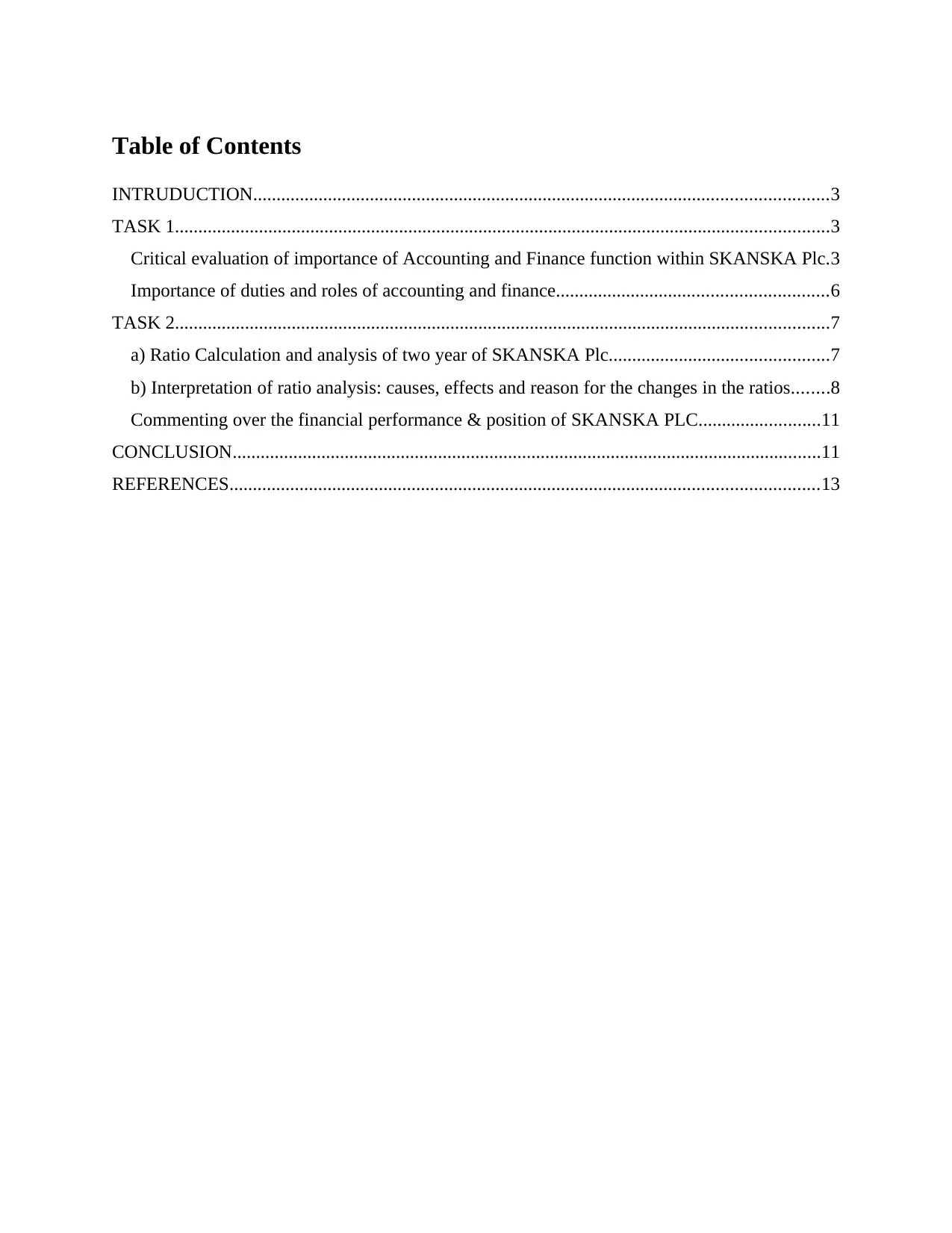
Table of Contents
INTRUDUCTION...........................................................................................................................3
TASK 1............................................................................................................................................3
Critical evaluation of importance of Accounting and Finance function within SKANSKA Plc.3
Importance of duties and roles of accounting and finance..........................................................6
TASK 2............................................................................................................................................7
a) Ratio Calculation and analysis of two year of SKANSKA Plc...............................................7
b) Interpretation of ratio analysis: causes, effects and reason for the changes in the ratios........8
Commenting over the financial performance & position of SKANSKA PLC..........................11
CONCLUSION..............................................................................................................................11
REFERENCES..............................................................................................................................13
INTRUDUCTION...........................................................................................................................3
TASK 1............................................................................................................................................3
Critical evaluation of importance of Accounting and Finance function within SKANSKA Plc.3
Importance of duties and roles of accounting and finance..........................................................6
TASK 2............................................................................................................................................7
a) Ratio Calculation and analysis of two year of SKANSKA Plc...............................................7
b) Interpretation of ratio analysis: causes, effects and reason for the changes in the ratios........8
Commenting over the financial performance & position of SKANSKA PLC..........................11
CONCLUSION..............................................................................................................................11
REFERENCES..............................................................................................................................13
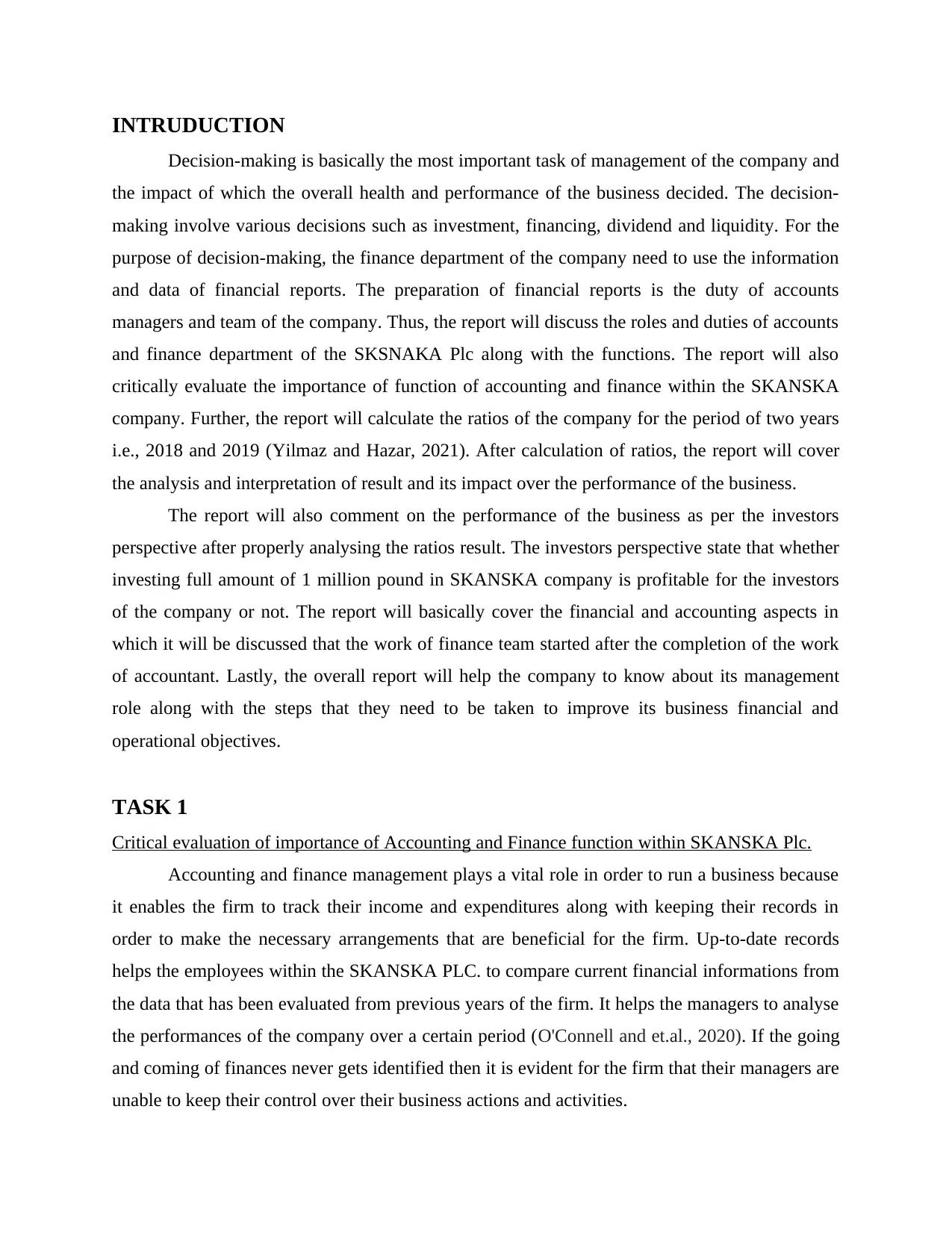
INTRUDUCTION
Decision-making is basically the most important task of management of the company and
the impact of which the overall health and performance of the business decided. The decision-
making involve various decisions such as investment, financing, dividend and liquidity. For the
purpose of decision-making, the finance department of the company need to use the information
and data of financial reports. The preparation of financial reports is the duty of accounts
managers and team of the company. Thus, the report will discuss the roles and duties of accounts
and finance department of the SKSNAKA Plc along with the functions. The report will also
critically evaluate the importance of function of accounting and finance within the SKANSKA
company. Further, the report will calculate the ratios of the company for the period of two years
i.e., 2018 and 2019 (Yilmaz and Hazar, 2021). After calculation of ratios, the report will cover
the analysis and interpretation of result and its impact over the performance of the business.
The report will also comment on the performance of the business as per the investors
perspective after properly analysing the ratios result. The investors perspective state that whether
investing full amount of 1 million pound in SKANSKA company is profitable for the investors
of the company or not. The report will basically cover the financial and accounting aspects in
which it will be discussed that the work of finance team started after the completion of the work
of accountant. Lastly, the overall report will help the company to know about its management
role along with the steps that they need to be taken to improve its business financial and
operational objectives.
TASK 1
Critical evaluation of importance of Accounting and Finance function within SKANSKA Plc.
Accounting and finance management plays a vital role in order to run a business because
it enables the firm to track their income and expenditures along with keeping their records in
order to make the necessary arrangements that are beneficial for the firm. Up-to-date records
helps the employees within the SKANSKA PLC. to compare current financial informations from
the data that has been evaluated from previous years of the firm. It helps the managers to analyse
the performances of the company over a certain period (O'Connell and et.al., 2020). If the going
and coming of finances never gets identified then it is evident for the firm that their managers are
unable to keep their control over their business actions and activities.
Decision-making is basically the most important task of management of the company and
the impact of which the overall health and performance of the business decided. The decision-
making involve various decisions such as investment, financing, dividend and liquidity. For the
purpose of decision-making, the finance department of the company need to use the information
and data of financial reports. The preparation of financial reports is the duty of accounts
managers and team of the company. Thus, the report will discuss the roles and duties of accounts
and finance department of the SKSNAKA Plc along with the functions. The report will also
critically evaluate the importance of function of accounting and finance within the SKANSKA
company. Further, the report will calculate the ratios of the company for the period of two years
i.e., 2018 and 2019 (Yilmaz and Hazar, 2021). After calculation of ratios, the report will cover
the analysis and interpretation of result and its impact over the performance of the business.
The report will also comment on the performance of the business as per the investors
perspective after properly analysing the ratios result. The investors perspective state that whether
investing full amount of 1 million pound in SKANSKA company is profitable for the investors
of the company or not. The report will basically cover the financial and accounting aspects in
which it will be discussed that the work of finance team started after the completion of the work
of accountant. Lastly, the overall report will help the company to know about its management
role along with the steps that they need to be taken to improve its business financial and
operational objectives.
TASK 1
Critical evaluation of importance of Accounting and Finance function within SKANSKA Plc.
Accounting and finance management plays a vital role in order to run a business because
it enables the firm to track their income and expenditures along with keeping their records in
order to make the necessary arrangements that are beneficial for the firm. Up-to-date records
helps the employees within the SKANSKA PLC. to compare current financial informations from
the data that has been evaluated from previous years of the firm. It helps the managers to analyse
the performances of the company over a certain period (O'Connell and et.al., 2020). If the going
and coming of finances never gets identified then it is evident for the firm that their managers are
unable to keep their control over their business actions and activities.
⊘ This is a preview!⊘
Do you want full access?
Subscribe today to unlock all pages.

Trusted by 1+ million students worldwide
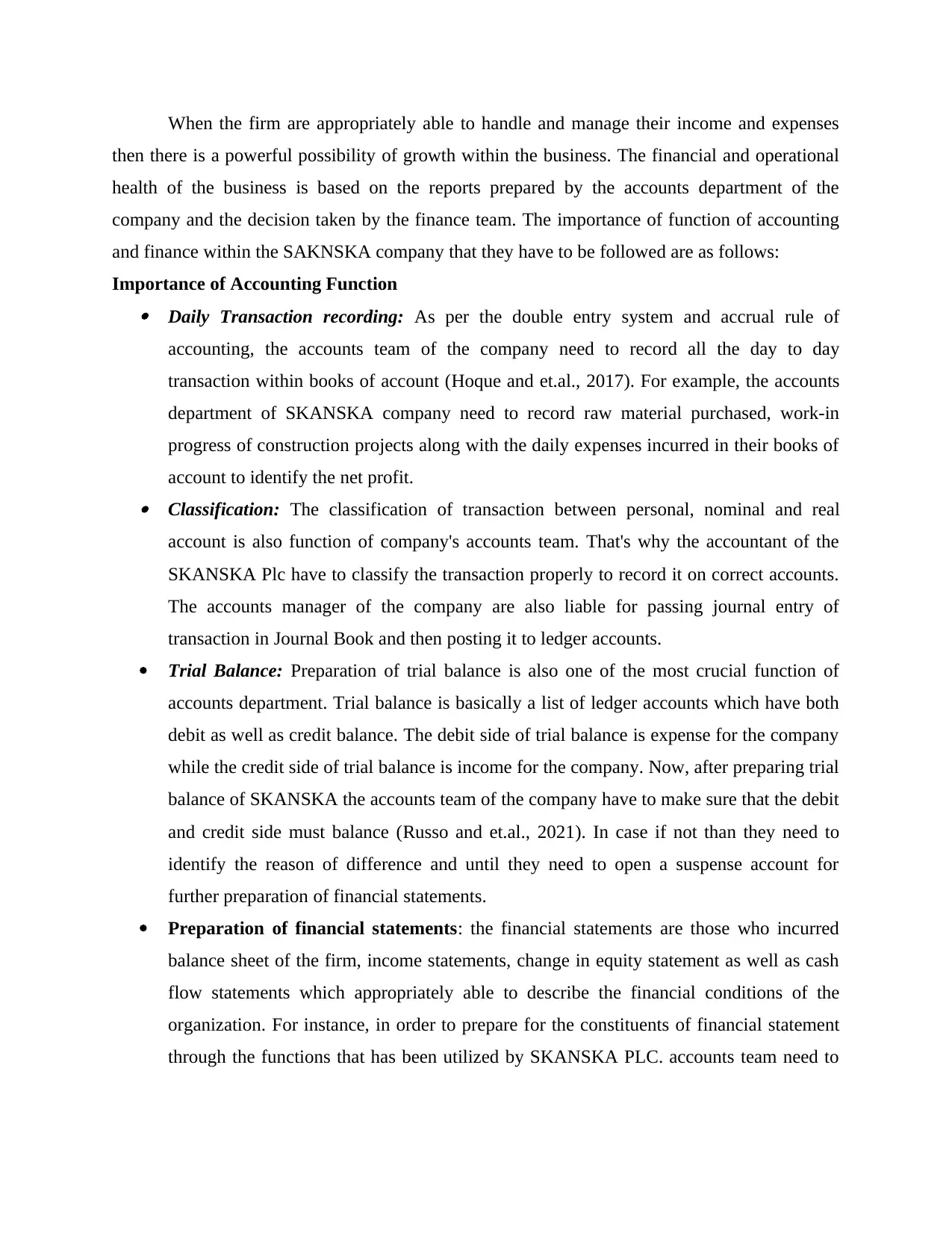
When the firm are appropriately able to handle and manage their income and expenses
then there is a powerful possibility of growth within the business. The financial and operational
health of the business is based on the reports prepared by the accounts department of the
company and the decision taken by the finance team. The importance of function of accounting
and finance within the SAKNSKA company that they have to be followed are as follows:
Importance of Accounting Function Daily Transaction recording: As per the double entry system and accrual rule of
accounting, the accounts team of the company need to record all the day to day
transaction within books of account (Hoque and et.al., 2017). For example, the accounts
department of SKANSKA company need to record raw material purchased, work-in
progress of construction projects along with the daily expenses incurred in their books of
account to identify the net profit. Classification: The classification of transaction between personal, nominal and real
account is also function of company's accounts team. That's why the accountant of the
SKANSKA Plc have to classify the transaction properly to record it on correct accounts.
The accounts manager of the company are also liable for passing journal entry of
transaction in Journal Book and then posting it to ledger accounts.
Trial Balance: Preparation of trial balance is also one of the most crucial function of
accounts department. Trial balance is basically a list of ledger accounts which have both
debit as well as credit balance. The debit side of trial balance is expense for the company
while the credit side of trial balance is income for the company. Now, after preparing trial
balance of SKANSKA the accounts team of the company have to make sure that the debit
and credit side must balance (Russo and et.al., 2021). In case if not than they need to
identify the reason of difference and until they need to open a suspense account for
further preparation of financial statements.
Preparation of financial statements: the financial statements are those who incurred
balance sheet of the firm, income statements, change in equity statement as well as cash
flow statements which appropriately able to describe the financial conditions of the
organization. For instance, in order to prepare for the constituents of financial statement
through the functions that has been utilized by SKANSKA PLC. accounts team need to
then there is a powerful possibility of growth within the business. The financial and operational
health of the business is based on the reports prepared by the accounts department of the
company and the decision taken by the finance team. The importance of function of accounting
and finance within the SAKNSKA company that they have to be followed are as follows:
Importance of Accounting Function Daily Transaction recording: As per the double entry system and accrual rule of
accounting, the accounts team of the company need to record all the day to day
transaction within books of account (Hoque and et.al., 2017). For example, the accounts
department of SKANSKA company need to record raw material purchased, work-in
progress of construction projects along with the daily expenses incurred in their books of
account to identify the net profit. Classification: The classification of transaction between personal, nominal and real
account is also function of company's accounts team. That's why the accountant of the
SKANSKA Plc have to classify the transaction properly to record it on correct accounts.
The accounts manager of the company are also liable for passing journal entry of
transaction in Journal Book and then posting it to ledger accounts.
Trial Balance: Preparation of trial balance is also one of the most crucial function of
accounts department. Trial balance is basically a list of ledger accounts which have both
debit as well as credit balance. The debit side of trial balance is expense for the company
while the credit side of trial balance is income for the company. Now, after preparing trial
balance of SKANSKA the accounts team of the company have to make sure that the debit
and credit side must balance (Russo and et.al., 2021). In case if not than they need to
identify the reason of difference and until they need to open a suspense account for
further preparation of financial statements.
Preparation of financial statements: the financial statements are those who incurred
balance sheet of the firm, income statements, change in equity statement as well as cash
flow statements which appropriately able to describe the financial conditions of the
organization. For instance, in order to prepare for the constituents of financial statement
through the functions that has been utilized by SKANSKA PLC. accounts team need to
Paraphrase This Document
Need a fresh take? Get an instant paraphrase of this document with our AI Paraphraser
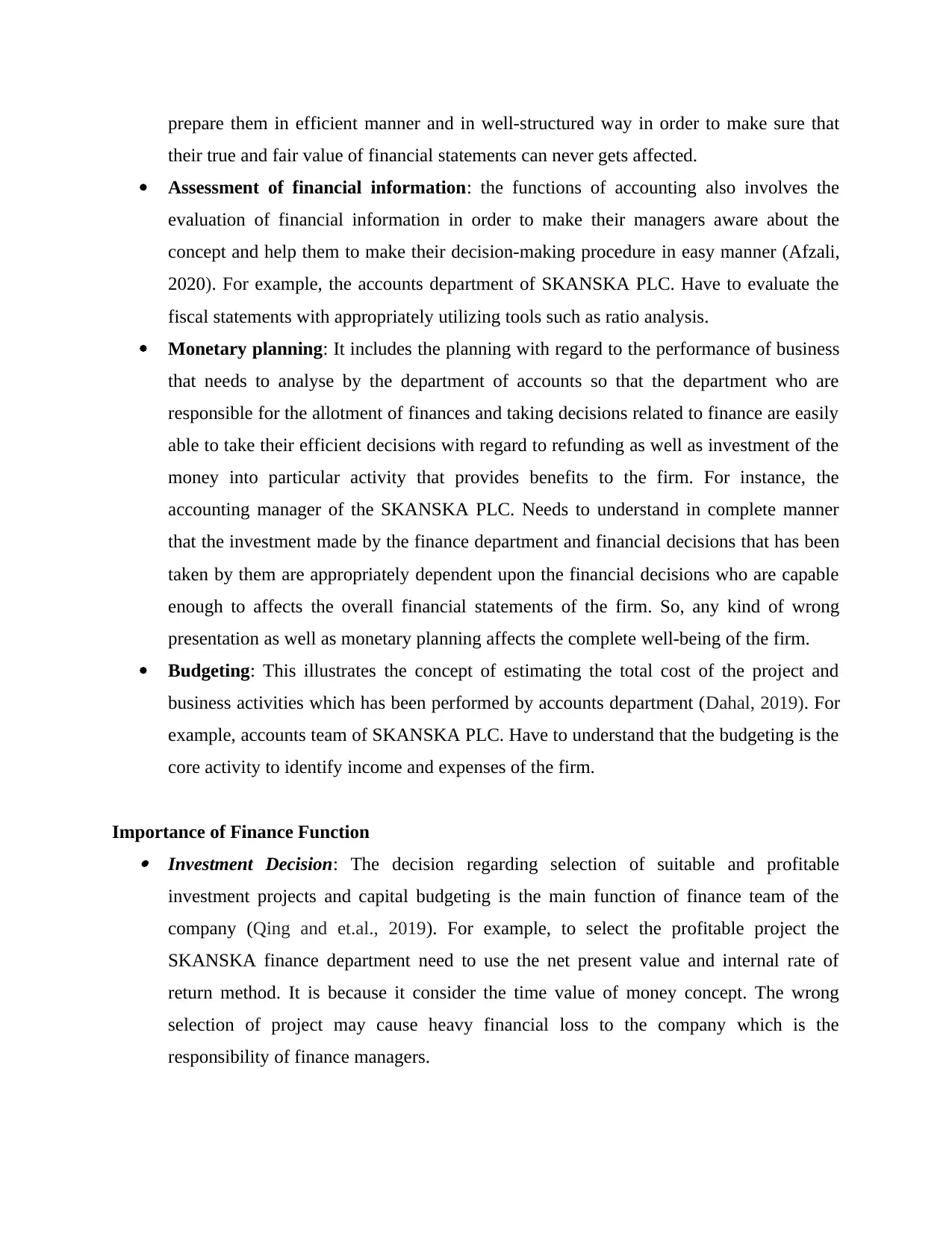
prepare them in efficient manner and in well-structured way in order to make sure that
their true and fair value of financial statements can never gets affected.
Assessment of financial information: the functions of accounting also involves the
evaluation of financial information in order to make their managers aware about the
concept and help them to make their decision-making procedure in easy manner (Afzali,
2020). For example, the accounts department of SKANSKA PLC. Have to evaluate the
fiscal statements with appropriately utilizing tools such as ratio analysis.
Monetary planning: It includes the planning with regard to the performance of business
that needs to analyse by the department of accounts so that the department who are
responsible for the allotment of finances and taking decisions related to finance are easily
able to take their efficient decisions with regard to refunding as well as investment of the
money into particular activity that provides benefits to the firm. For instance, the
accounting manager of the SKANSKA PLC. Needs to understand in complete manner
that the investment made by the finance department and financial decisions that has been
taken by them are appropriately dependent upon the financial decisions who are capable
enough to affects the overall financial statements of the firm. So, any kind of wrong
presentation as well as monetary planning affects the complete well-being of the firm.
Budgeting: This illustrates the concept of estimating the total cost of the project and
business activities which has been performed by accounts department (Dahal, 2019). For
example, accounts team of SKANSKA PLC. Have to understand that the budgeting is the
core activity to identify income and expenses of the firm.
Importance of Finance Function Investment Decision: The decision regarding selection of suitable and profitable
investment projects and capital budgeting is the main function of finance team of the
company (Qing and et.al., 2019). For example, to select the profitable project the
SKANSKA finance department need to use the net present value and internal rate of
return method. It is because it consider the time value of money concept. The wrong
selection of project may cause heavy financial loss to the company which is the
responsibility of finance managers.
their true and fair value of financial statements can never gets affected.
Assessment of financial information: the functions of accounting also involves the
evaluation of financial information in order to make their managers aware about the
concept and help them to make their decision-making procedure in easy manner (Afzali,
2020). For example, the accounts department of SKANSKA PLC. Have to evaluate the
fiscal statements with appropriately utilizing tools such as ratio analysis.
Monetary planning: It includes the planning with regard to the performance of business
that needs to analyse by the department of accounts so that the department who are
responsible for the allotment of finances and taking decisions related to finance are easily
able to take their efficient decisions with regard to refunding as well as investment of the
money into particular activity that provides benefits to the firm. For instance, the
accounting manager of the SKANSKA PLC. Needs to understand in complete manner
that the investment made by the finance department and financial decisions that has been
taken by them are appropriately dependent upon the financial decisions who are capable
enough to affects the overall financial statements of the firm. So, any kind of wrong
presentation as well as monetary planning affects the complete well-being of the firm.
Budgeting: This illustrates the concept of estimating the total cost of the project and
business activities which has been performed by accounts department (Dahal, 2019). For
example, accounts team of SKANSKA PLC. Have to understand that the budgeting is the
core activity to identify income and expenses of the firm.
Importance of Finance Function Investment Decision: The decision regarding selection of suitable and profitable
investment projects and capital budgeting is the main function of finance team of the
company (Qing and et.al., 2019). For example, to select the profitable project the
SKANSKA finance department need to use the net present value and internal rate of
return method. It is because it consider the time value of money concept. The wrong
selection of project may cause heavy financial loss to the company which is the
responsibility of finance managers.
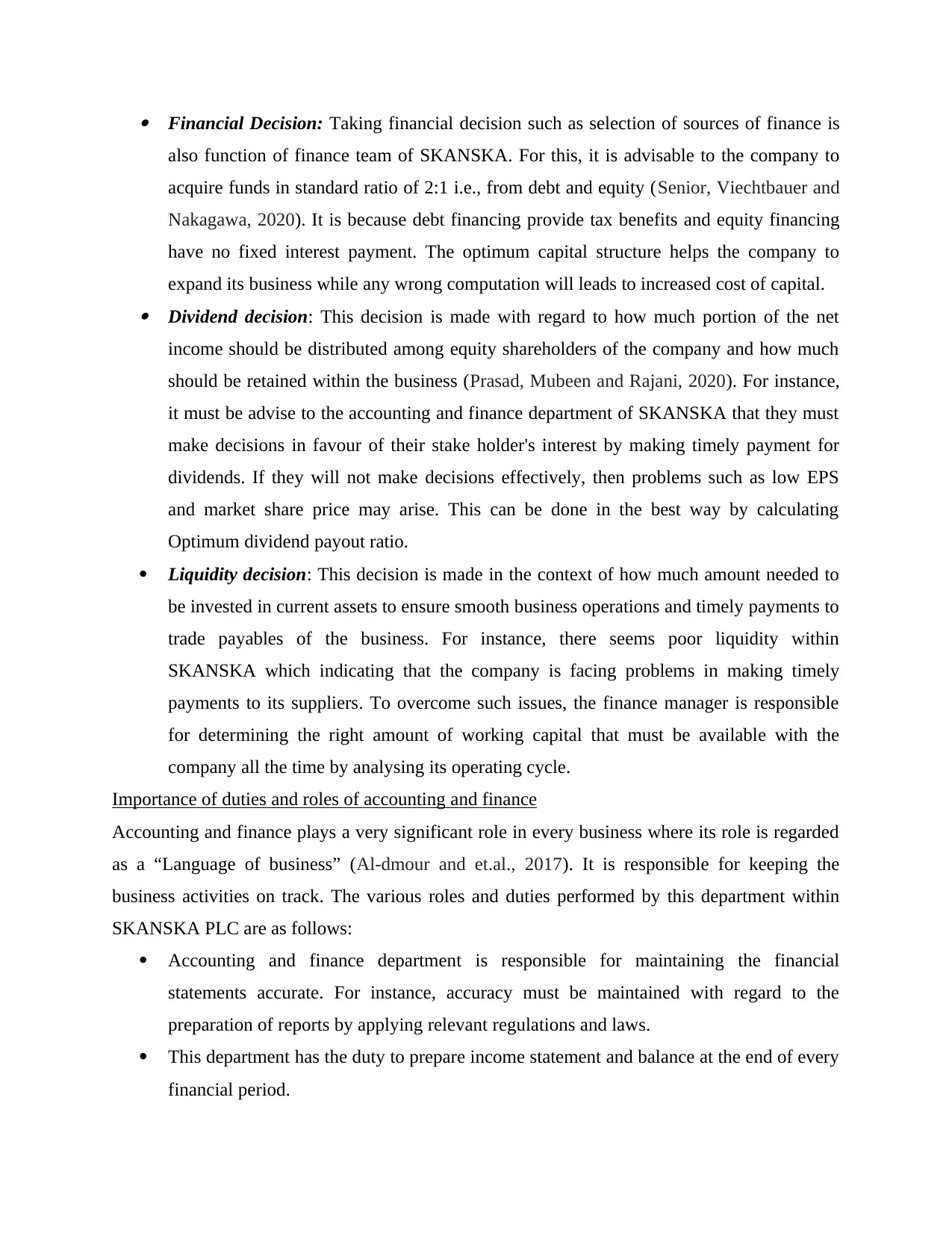
Financial Decision: Taking financial decision such as selection of sources of finance is
also function of finance team of SKANSKA. For this, it is advisable to the company to
acquire funds in standard ratio of 2:1 i.e., from debt and equity (Senior, Viechtbauer and
Nakagawa, 2020). It is because debt financing provide tax benefits and equity financing
have no fixed interest payment. The optimum capital structure helps the company to
expand its business while any wrong computation will leads to increased cost of capital. Dividend decision: This decision is made with regard to how much portion of the net
income should be distributed among equity shareholders of the company and how much
should be retained within the business (Prasad, Mubeen and Rajani, 2020). For instance,
it must be advise to the accounting and finance department of SKANSKA that they must
make decisions in favour of their stake holder's interest by making timely payment for
dividends. If they will not make decisions effectively, then problems such as low EPS
and market share price may arise. This can be done in the best way by calculating
Optimum dividend payout ratio.
Liquidity decision: This decision is made in the context of how much amount needed to
be invested in current assets to ensure smooth business operations and timely payments to
trade payables of the business. For instance, there seems poor liquidity within
SKANSKA which indicating that the company is facing problems in making timely
payments to its suppliers. To overcome such issues, the finance manager is responsible
for determining the right amount of working capital that must be available with the
company all the time by analysing its operating cycle.
Importance of duties and roles of accounting and finance
Accounting and finance plays a very significant role in every business where its role is regarded
as a “Language of business” (Al-dmour and et.al., 2017). It is responsible for keeping the
business activities on track. The various roles and duties performed by this department within
SKANSKA PLC are as follows:
Accounting and finance department is responsible for maintaining the financial
statements accurate. For instance, accuracy must be maintained with regard to the
preparation of reports by applying relevant regulations and laws.
This department has the duty to prepare income statement and balance at the end of every
financial period.
also function of finance team of SKANSKA. For this, it is advisable to the company to
acquire funds in standard ratio of 2:1 i.e., from debt and equity (Senior, Viechtbauer and
Nakagawa, 2020). It is because debt financing provide tax benefits and equity financing
have no fixed interest payment. The optimum capital structure helps the company to
expand its business while any wrong computation will leads to increased cost of capital. Dividend decision: This decision is made with regard to how much portion of the net
income should be distributed among equity shareholders of the company and how much
should be retained within the business (Prasad, Mubeen and Rajani, 2020). For instance,
it must be advise to the accounting and finance department of SKANSKA that they must
make decisions in favour of their stake holder's interest by making timely payment for
dividends. If they will not make decisions effectively, then problems such as low EPS
and market share price may arise. This can be done in the best way by calculating
Optimum dividend payout ratio.
Liquidity decision: This decision is made in the context of how much amount needed to
be invested in current assets to ensure smooth business operations and timely payments to
trade payables of the business. For instance, there seems poor liquidity within
SKANSKA which indicating that the company is facing problems in making timely
payments to its suppliers. To overcome such issues, the finance manager is responsible
for determining the right amount of working capital that must be available with the
company all the time by analysing its operating cycle.
Importance of duties and roles of accounting and finance
Accounting and finance plays a very significant role in every business where its role is regarded
as a “Language of business” (Al-dmour and et.al., 2017). It is responsible for keeping the
business activities on track. The various roles and duties performed by this department within
SKANSKA PLC are as follows:
Accounting and finance department is responsible for maintaining the financial
statements accurate. For instance, accuracy must be maintained with regard to the
preparation of reports by applying relevant regulations and laws.
This department has the duty to prepare income statement and balance at the end of every
financial period.
⊘ This is a preview!⊘
Do you want full access?
Subscribe today to unlock all pages.

Trusted by 1+ million students worldwide
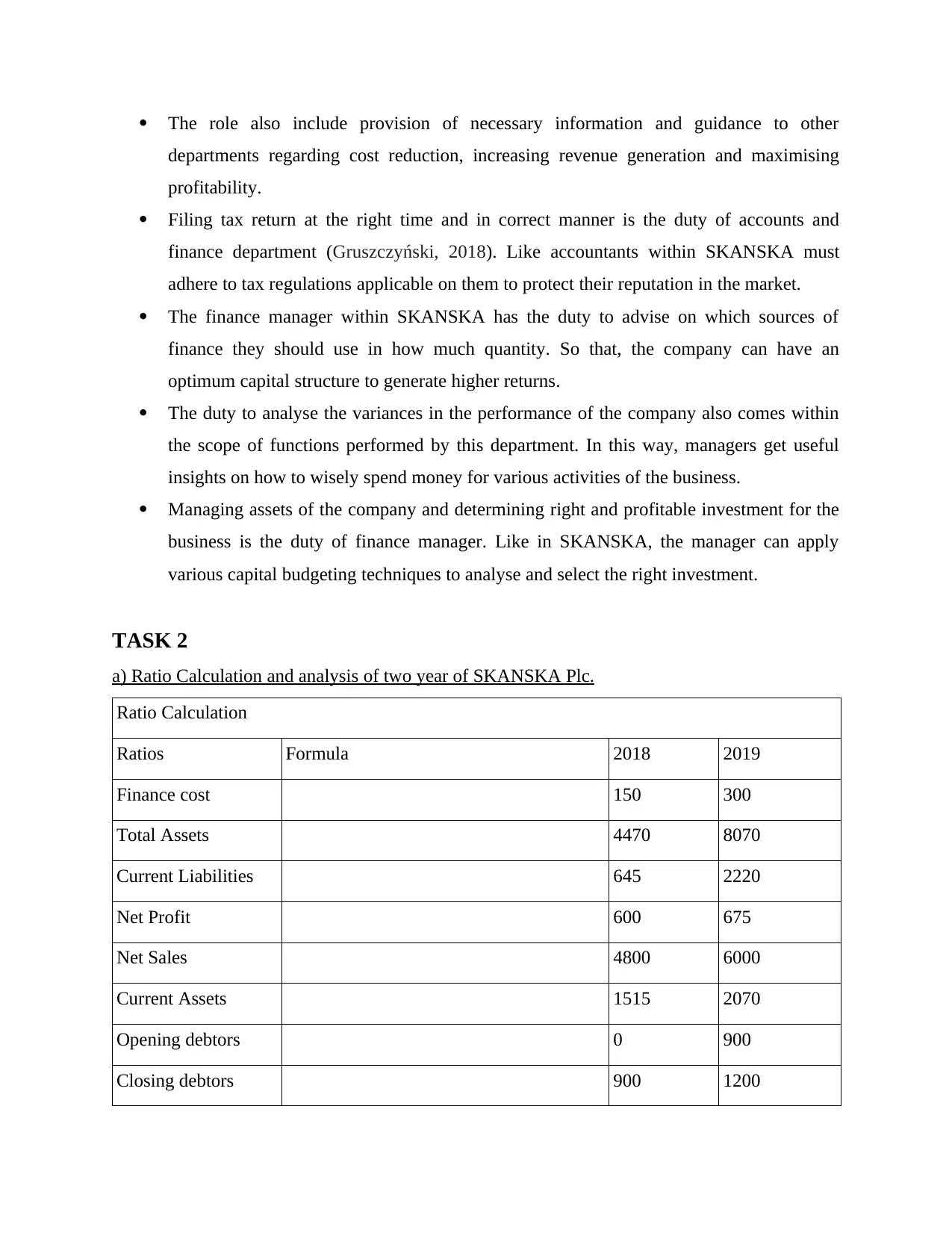
The role also include provision of necessary information and guidance to other
departments regarding cost reduction, increasing revenue generation and maximising
profitability.
Filing tax return at the right time and in correct manner is the duty of accounts and
finance department (Gruszczyński, 2018). Like accountants within SKANSKA must
adhere to tax regulations applicable on them to protect their reputation in the market.
The finance manager within SKANSKA has the duty to advise on which sources of
finance they should use in how much quantity. So that, the company can have an
optimum capital structure to generate higher returns.
The duty to analyse the variances in the performance of the company also comes within
the scope of functions performed by this department. In this way, managers get useful
insights on how to wisely spend money for various activities of the business.
Managing assets of the company and determining right and profitable investment for the
business is the duty of finance manager. Like in SKANSKA, the manager can apply
various capital budgeting techniques to analyse and select the right investment.
TASK 2
a) Ratio Calculation and analysis of two year of SKANSKA Plc.
Ratio Calculation
Ratios Formula 2018 2019
Finance cost 150 300
Total Assets 4470 8070
Current Liabilities 645 2220
Net Profit 600 675
Net Sales 4800 6000
Current Assets 1515 2070
Opening debtors 0 900
Closing debtors 900 1200
departments regarding cost reduction, increasing revenue generation and maximising
profitability.
Filing tax return at the right time and in correct manner is the duty of accounts and
finance department (Gruszczyński, 2018). Like accountants within SKANSKA must
adhere to tax regulations applicable on them to protect their reputation in the market.
The finance manager within SKANSKA has the duty to advise on which sources of
finance they should use in how much quantity. So that, the company can have an
optimum capital structure to generate higher returns.
The duty to analyse the variances in the performance of the company also comes within
the scope of functions performed by this department. In this way, managers get useful
insights on how to wisely spend money for various activities of the business.
Managing assets of the company and determining right and profitable investment for the
business is the duty of finance manager. Like in SKANSKA, the manager can apply
various capital budgeting techniques to analyse and select the right investment.
TASK 2
a) Ratio Calculation and analysis of two year of SKANSKA Plc.
Ratio Calculation
Ratios Formula 2018 2019
Finance cost 150 300
Total Assets 4470 8070
Current Liabilities 645 2220
Net Profit 600 675
Net Sales 4800 6000
Current Assets 1515 2070
Opening debtors 0 900
Closing debtors 900 1200
Paraphrase This Document
Need a fresh take? Get an instant paraphrase of this document with our AI Paraphraser
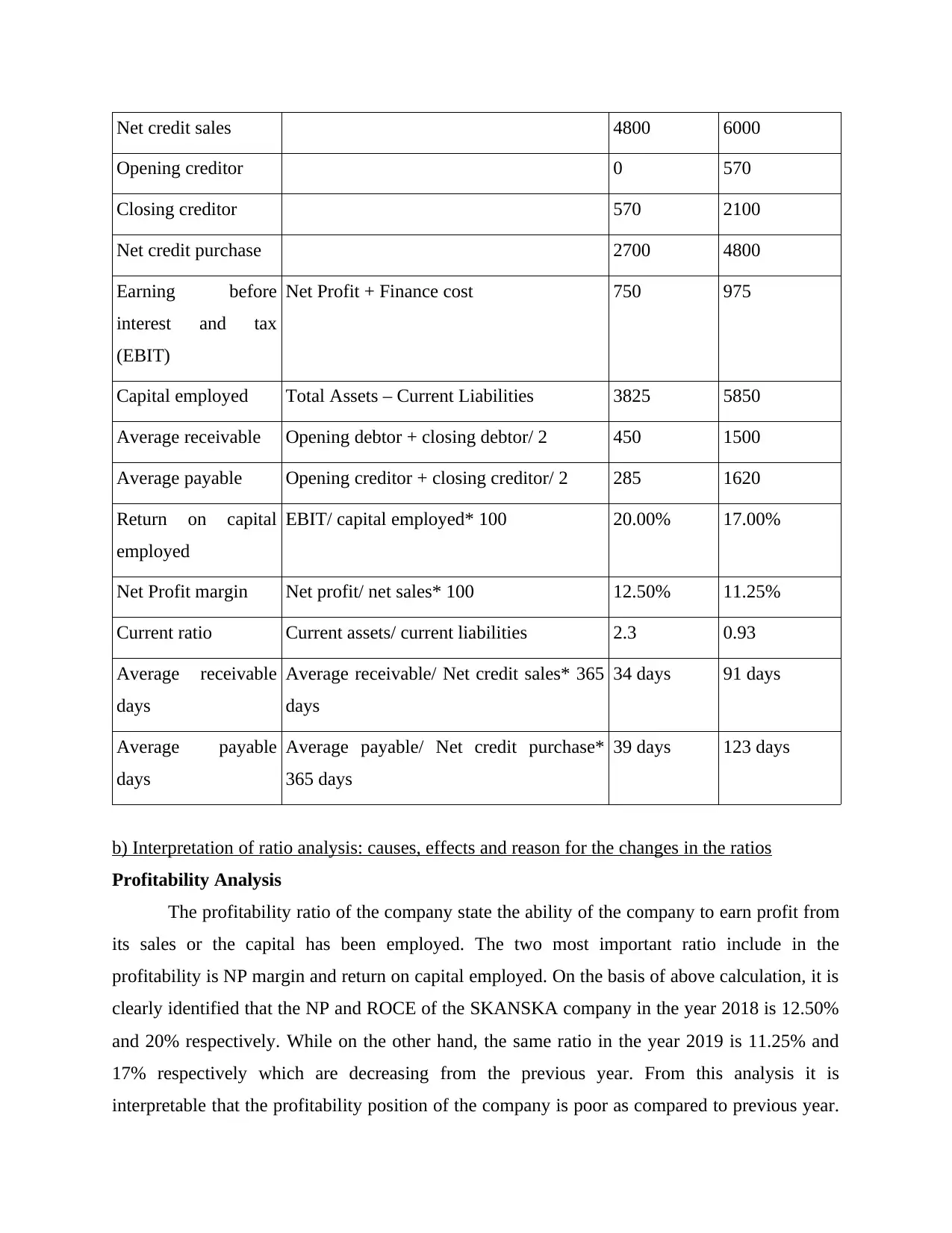
Net credit sales 4800 6000
Opening creditor 0 570
Closing creditor 570 2100
Net credit purchase 2700 4800
Earning before
interest and tax
(EBIT)
Net Profit + Finance cost 750 975
Capital employed Total Assets – Current Liabilities 3825 5850
Average receivable Opening debtor + closing debtor/ 2 450 1500
Average payable Opening creditor + closing creditor/ 2 285 1620
Return on capital
employed
EBIT/ capital employed* 100 20.00% 17.00%
Net Profit margin Net profit/ net sales* 100 12.50% 11.25%
Current ratio Current assets/ current liabilities 2.3 0.93
Average receivable
days
Average receivable/ Net credit sales* 365
days
34 days 91 days
Average payable
days
Average payable/ Net credit purchase*
365 days
39 days 123 days
b) Interpretation of ratio analysis: causes, effects and reason for the changes in the ratios
Profitability Analysis
The profitability ratio of the company state the ability of the company to earn profit from
its sales or the capital has been employed. The two most important ratio include in the
profitability is NP margin and return on capital employed. On the basis of above calculation, it is
clearly identified that the NP and ROCE of the SKANSKA company in the year 2018 is 12.50%
and 20% respectively. While on the other hand, the same ratio in the year 2019 is 11.25% and
17% respectively which are decreasing from the previous year. From this analysis it is
interpretable that the profitability position of the company is poor as compared to previous year.
Opening creditor 0 570
Closing creditor 570 2100
Net credit purchase 2700 4800
Earning before
interest and tax
(EBIT)
Net Profit + Finance cost 750 975
Capital employed Total Assets – Current Liabilities 3825 5850
Average receivable Opening debtor + closing debtor/ 2 450 1500
Average payable Opening creditor + closing creditor/ 2 285 1620
Return on capital
employed
EBIT/ capital employed* 100 20.00% 17.00%
Net Profit margin Net profit/ net sales* 100 12.50% 11.25%
Current ratio Current assets/ current liabilities 2.3 0.93
Average receivable
days
Average receivable/ Net credit sales* 365
days
34 days 91 days
Average payable
days
Average payable/ Net credit purchase*
365 days
39 days 123 days
b) Interpretation of ratio analysis: causes, effects and reason for the changes in the ratios
Profitability Analysis
The profitability ratio of the company state the ability of the company to earn profit from
its sales or the capital has been employed. The two most important ratio include in the
profitability is NP margin and return on capital employed. On the basis of above calculation, it is
clearly identified that the NP and ROCE of the SKANSKA company in the year 2018 is 12.50%
and 20% respectively. While on the other hand, the same ratio in the year 2019 is 11.25% and
17% respectively which are decreasing from the previous year. From this analysis it is
interpretable that the profitability position of the company is poor as compared to previous year.
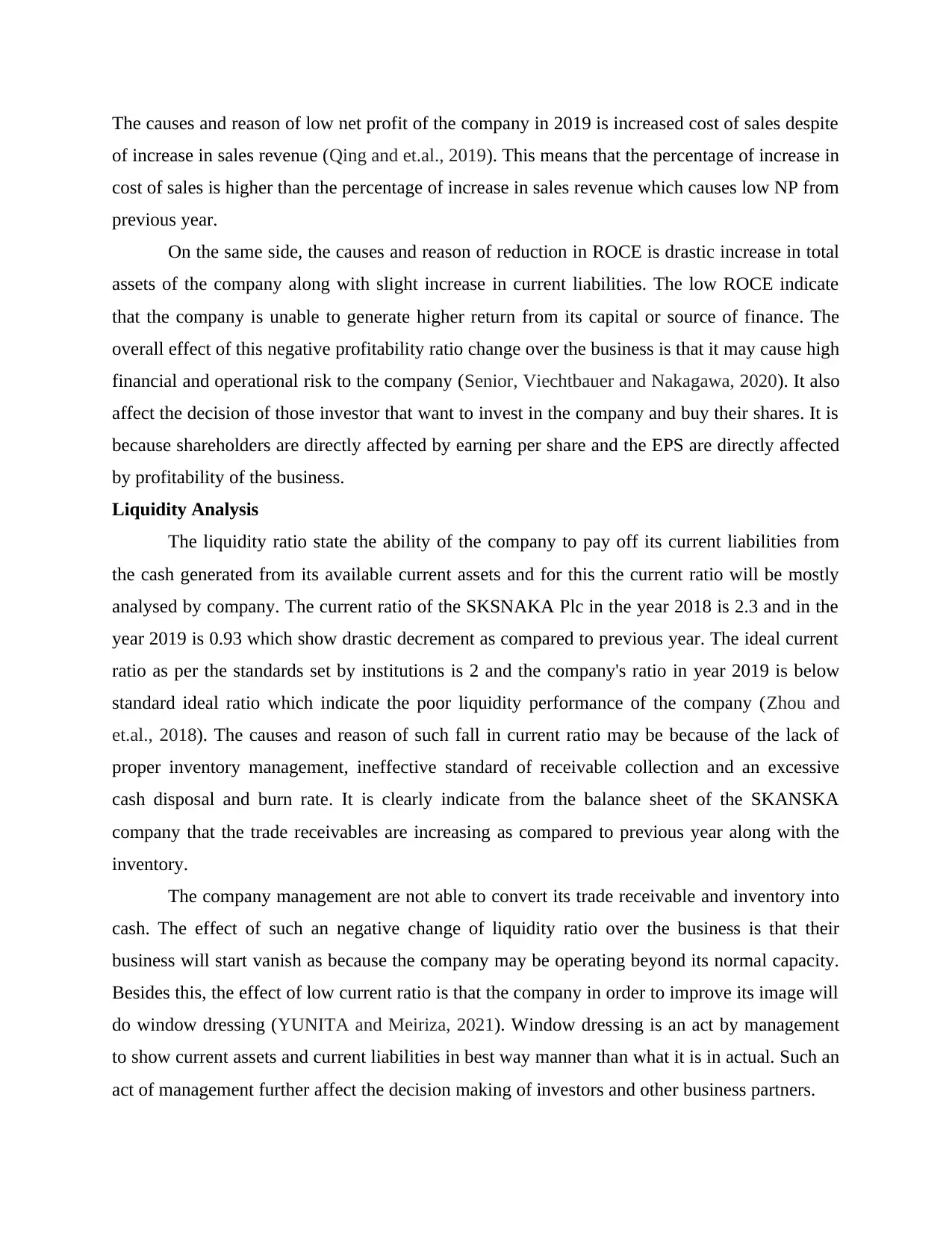
The causes and reason of low net profit of the company in 2019 is increased cost of sales despite
of increase in sales revenue (Qing and et.al., 2019). This means that the percentage of increase in
cost of sales is higher than the percentage of increase in sales revenue which causes low NP from
previous year.
On the same side, the causes and reason of reduction in ROCE is drastic increase in total
assets of the company along with slight increase in current liabilities. The low ROCE indicate
that the company is unable to generate higher return from its capital or source of finance. The
overall effect of this negative profitability ratio change over the business is that it may cause high
financial and operational risk to the company (Senior, Viechtbauer and Nakagawa, 2020). It also
affect the decision of those investor that want to invest in the company and buy their shares. It is
because shareholders are directly affected by earning per share and the EPS are directly affected
by profitability of the business.
Liquidity Analysis
The liquidity ratio state the ability of the company to pay off its current liabilities from
the cash generated from its available current assets and for this the current ratio will be mostly
analysed by company. The current ratio of the SKSNAKA Plc in the year 2018 is 2.3 and in the
year 2019 is 0.93 which show drastic decrement as compared to previous year. The ideal current
ratio as per the standards set by institutions is 2 and the company's ratio in year 2019 is below
standard ideal ratio which indicate the poor liquidity performance of the company (Zhou and
et.al., 2018). The causes and reason of such fall in current ratio may be because of the lack of
proper inventory management, ineffective standard of receivable collection and an excessive
cash disposal and burn rate. It is clearly indicate from the balance sheet of the SKANSKA
company that the trade receivables are increasing as compared to previous year along with the
inventory.
The company management are not able to convert its trade receivable and inventory into
cash. The effect of such an negative change of liquidity ratio over the business is that their
business will start vanish as because the company may be operating beyond its normal capacity.
Besides this, the effect of low current ratio is that the company in order to improve its image will
do window dressing (YUNITA and Meiriza, 2021). Window dressing is an act by management
to show current assets and current liabilities in best way manner than what it is in actual. Such an
act of management further affect the decision making of investors and other business partners.
of increase in sales revenue (Qing and et.al., 2019). This means that the percentage of increase in
cost of sales is higher than the percentage of increase in sales revenue which causes low NP from
previous year.
On the same side, the causes and reason of reduction in ROCE is drastic increase in total
assets of the company along with slight increase in current liabilities. The low ROCE indicate
that the company is unable to generate higher return from its capital or source of finance. The
overall effect of this negative profitability ratio change over the business is that it may cause high
financial and operational risk to the company (Senior, Viechtbauer and Nakagawa, 2020). It also
affect the decision of those investor that want to invest in the company and buy their shares. It is
because shareholders are directly affected by earning per share and the EPS are directly affected
by profitability of the business.
Liquidity Analysis
The liquidity ratio state the ability of the company to pay off its current liabilities from
the cash generated from its available current assets and for this the current ratio will be mostly
analysed by company. The current ratio of the SKSNAKA Plc in the year 2018 is 2.3 and in the
year 2019 is 0.93 which show drastic decrement as compared to previous year. The ideal current
ratio as per the standards set by institutions is 2 and the company's ratio in year 2019 is below
standard ideal ratio which indicate the poor liquidity performance of the company (Zhou and
et.al., 2018). The causes and reason of such fall in current ratio may be because of the lack of
proper inventory management, ineffective standard of receivable collection and an excessive
cash disposal and burn rate. It is clearly indicate from the balance sheet of the SKANSKA
company that the trade receivables are increasing as compared to previous year along with the
inventory.
The company management are not able to convert its trade receivable and inventory into
cash. The effect of such an negative change of liquidity ratio over the business is that their
business will start vanish as because the company may be operating beyond its normal capacity.
Besides this, the effect of low current ratio is that the company in order to improve its image will
do window dressing (YUNITA and Meiriza, 2021). Window dressing is an act by management
to show current assets and current liabilities in best way manner than what it is in actual. Such an
act of management further affect the decision making of investors and other business partners.
⊘ This is a preview!⊘
Do you want full access?
Subscribe today to unlock all pages.

Trusted by 1+ million students worldwide
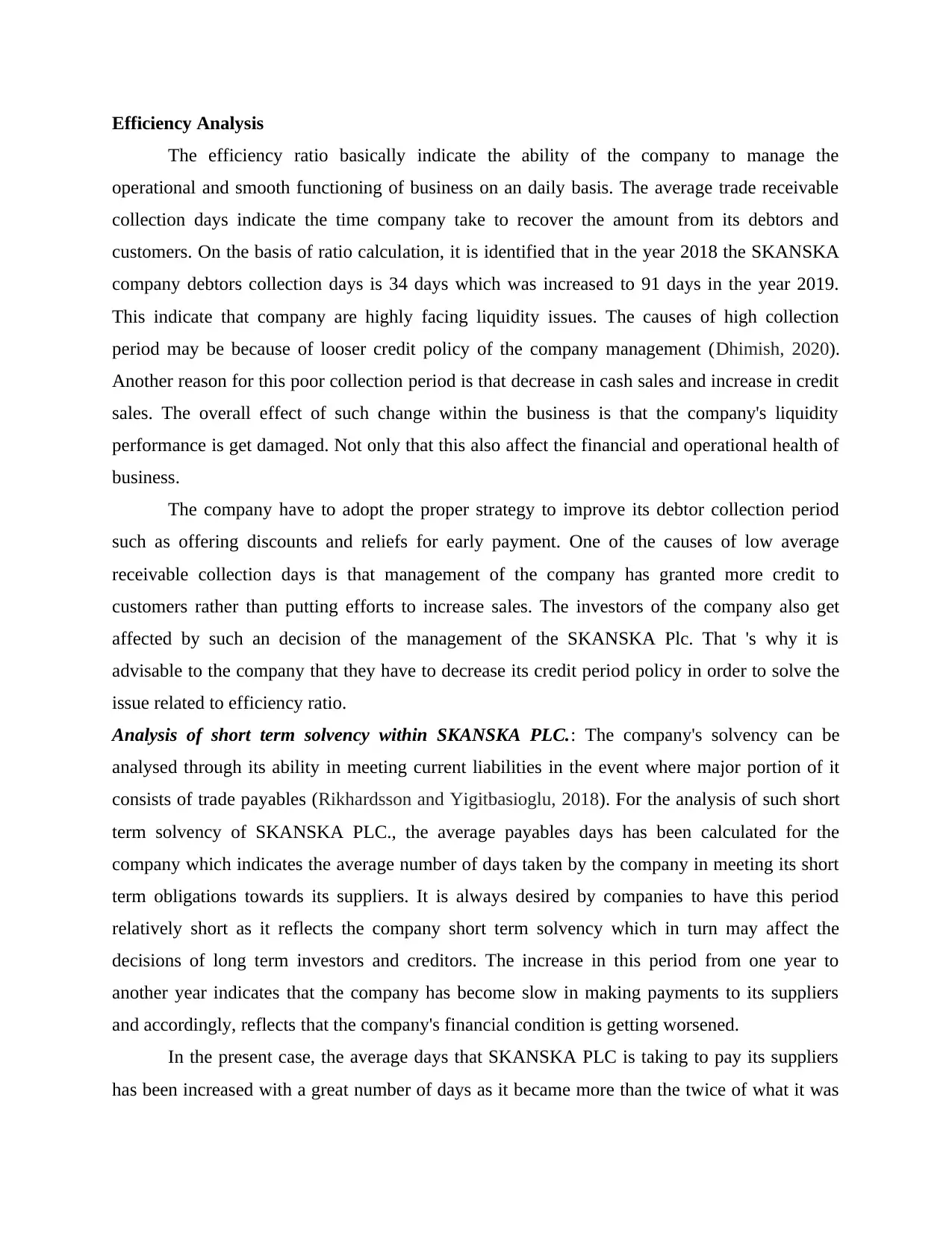
Efficiency Analysis
The efficiency ratio basically indicate the ability of the company to manage the
operational and smooth functioning of business on an daily basis. The average trade receivable
collection days indicate the time company take to recover the amount from its debtors and
customers. On the basis of ratio calculation, it is identified that in the year 2018 the SKANSKA
company debtors collection days is 34 days which was increased to 91 days in the year 2019.
This indicate that company are highly facing liquidity issues. The causes of high collection
period may be because of looser credit policy of the company management (Dhimish, 2020).
Another reason for this poor collection period is that decrease in cash sales and increase in credit
sales. The overall effect of such change within the business is that the company's liquidity
performance is get damaged. Not only that this also affect the financial and operational health of
business.
The company have to adopt the proper strategy to improve its debtor collection period
such as offering discounts and reliefs for early payment. One of the causes of low average
receivable collection days is that management of the company has granted more credit to
customers rather than putting efforts to increase sales. The investors of the company also get
affected by such an decision of the management of the SKANSKA Plc. That 's why it is
advisable to the company that they have to decrease its credit period policy in order to solve the
issue related to efficiency ratio.
Analysis of short term solvency within SKANSKA PLC.: The company's solvency can be
analysed through its ability in meeting current liabilities in the event where major portion of it
consists of trade payables (Rikhardsson and Yigitbasioglu, 2018). For the analysis of such short
term solvency of SKANSKA PLC., the average payables days has been calculated for the
company which indicates the average number of days taken by the company in meeting its short
term obligations towards its suppliers. It is always desired by companies to have this period
relatively short as it reflects the company short term solvency which in turn may affect the
decisions of long term investors and creditors. The increase in this period from one year to
another year indicates that the company has become slow in making payments to its suppliers
and accordingly, reflects that the company's financial condition is getting worsened.
In the present case, the average days that SKANSKA PLC is taking to pay its suppliers
has been increased with a great number of days as it became more than the twice of what it was
The efficiency ratio basically indicate the ability of the company to manage the
operational and smooth functioning of business on an daily basis. The average trade receivable
collection days indicate the time company take to recover the amount from its debtors and
customers. On the basis of ratio calculation, it is identified that in the year 2018 the SKANSKA
company debtors collection days is 34 days which was increased to 91 days in the year 2019.
This indicate that company are highly facing liquidity issues. The causes of high collection
period may be because of looser credit policy of the company management (Dhimish, 2020).
Another reason for this poor collection period is that decrease in cash sales and increase in credit
sales. The overall effect of such change within the business is that the company's liquidity
performance is get damaged. Not only that this also affect the financial and operational health of
business.
The company have to adopt the proper strategy to improve its debtor collection period
such as offering discounts and reliefs for early payment. One of the causes of low average
receivable collection days is that management of the company has granted more credit to
customers rather than putting efforts to increase sales. The investors of the company also get
affected by such an decision of the management of the SKANSKA Plc. That 's why it is
advisable to the company that they have to decrease its credit period policy in order to solve the
issue related to efficiency ratio.
Analysis of short term solvency within SKANSKA PLC.: The company's solvency can be
analysed through its ability in meeting current liabilities in the event where major portion of it
consists of trade payables (Rikhardsson and Yigitbasioglu, 2018). For the analysis of such short
term solvency of SKANSKA PLC., the average payables days has been calculated for the
company which indicates the average number of days taken by the company in meeting its short
term obligations towards its suppliers. It is always desired by companies to have this period
relatively short as it reflects the company short term solvency which in turn may affect the
decisions of long term investors and creditors. The increase in this period from one year to
another year indicates that the company has become slow in making payments to its suppliers
and accordingly, reflects that the company's financial condition is getting worsened.
In the present case, the average days that SKANSKA PLC is taking to pay its suppliers
has been increased with a great number of days as it became more than the twice of what it was
Paraphrase This Document
Need a fresh take? Get an instant paraphrase of this document with our AI Paraphraser
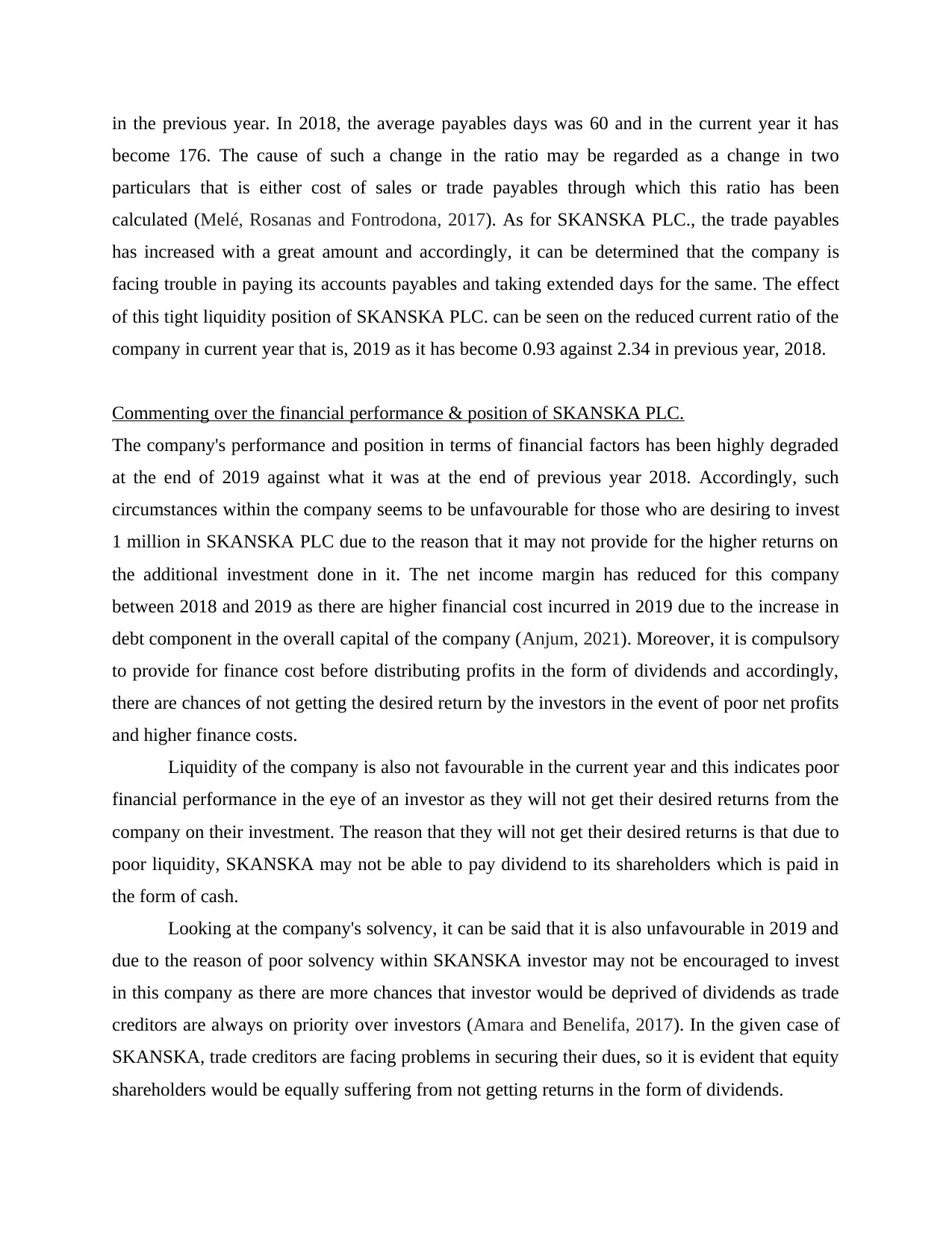
in the previous year. In 2018, the average payables days was 60 and in the current year it has
become 176. The cause of such a change in the ratio may be regarded as a change in two
particulars that is either cost of sales or trade payables through which this ratio has been
calculated (Melé, Rosanas and Fontrodona, 2017). As for SKANSKA PLC., the trade payables
has increased with a great amount and accordingly, it can be determined that the company is
facing trouble in paying its accounts payables and taking extended days for the same. The effect
of this tight liquidity position of SKANSKA PLC. can be seen on the reduced current ratio of the
company in current year that is, 2019 as it has become 0.93 against 2.34 in previous year, 2018.
Commenting over the financial performance & position of SKANSKA PLC.
The company's performance and position in terms of financial factors has been highly degraded
at the end of 2019 against what it was at the end of previous year 2018. Accordingly, such
circumstances within the company seems to be unfavourable for those who are desiring to invest
1 million in SKANSKA PLC due to the reason that it may not provide for the higher returns on
the additional investment done in it. The net income margin has reduced for this company
between 2018 and 2019 as there are higher financial cost incurred in 2019 due to the increase in
debt component in the overall capital of the company (Anjum, 2021). Moreover, it is compulsory
to provide for finance cost before distributing profits in the form of dividends and accordingly,
there are chances of not getting the desired return by the investors in the event of poor net profits
and higher finance costs.
Liquidity of the company is also not favourable in the current year and this indicates poor
financial performance in the eye of an investor as they will not get their desired returns from the
company on their investment. The reason that they will not get their desired returns is that due to
poor liquidity, SKANSKA may not be able to pay dividend to its shareholders which is paid in
the form of cash.
Looking at the company's solvency, it can be said that it is also unfavourable in 2019 and
due to the reason of poor solvency within SKANSKA investor may not be encouraged to invest
in this company as there are more chances that investor would be deprived of dividends as trade
creditors are always on priority over investors (Amara and Benelifa, 2017). In the given case of
SKANSKA, trade creditors are facing problems in securing their dues, so it is evident that equity
shareholders would be equally suffering from not getting returns in the form of dividends.
become 176. The cause of such a change in the ratio may be regarded as a change in two
particulars that is either cost of sales or trade payables through which this ratio has been
calculated (Melé, Rosanas and Fontrodona, 2017). As for SKANSKA PLC., the trade payables
has increased with a great amount and accordingly, it can be determined that the company is
facing trouble in paying its accounts payables and taking extended days for the same. The effect
of this tight liquidity position of SKANSKA PLC. can be seen on the reduced current ratio of the
company in current year that is, 2019 as it has become 0.93 against 2.34 in previous year, 2018.
Commenting over the financial performance & position of SKANSKA PLC.
The company's performance and position in terms of financial factors has been highly degraded
at the end of 2019 against what it was at the end of previous year 2018. Accordingly, such
circumstances within the company seems to be unfavourable for those who are desiring to invest
1 million in SKANSKA PLC due to the reason that it may not provide for the higher returns on
the additional investment done in it. The net income margin has reduced for this company
between 2018 and 2019 as there are higher financial cost incurred in 2019 due to the increase in
debt component in the overall capital of the company (Anjum, 2021). Moreover, it is compulsory
to provide for finance cost before distributing profits in the form of dividends and accordingly,
there are chances of not getting the desired return by the investors in the event of poor net profits
and higher finance costs.
Liquidity of the company is also not favourable in the current year and this indicates poor
financial performance in the eye of an investor as they will not get their desired returns from the
company on their investment. The reason that they will not get their desired returns is that due to
poor liquidity, SKANSKA may not be able to pay dividend to its shareholders which is paid in
the form of cash.
Looking at the company's solvency, it can be said that it is also unfavourable in 2019 and
due to the reason of poor solvency within SKANSKA investor may not be encouraged to invest
in this company as there are more chances that investor would be deprived of dividends as trade
creditors are always on priority over investors (Amara and Benelifa, 2017). In the given case of
SKANSKA, trade creditors are facing problems in securing their dues, so it is evident that equity
shareholders would be equally suffering from not getting returns in the form of dividends.
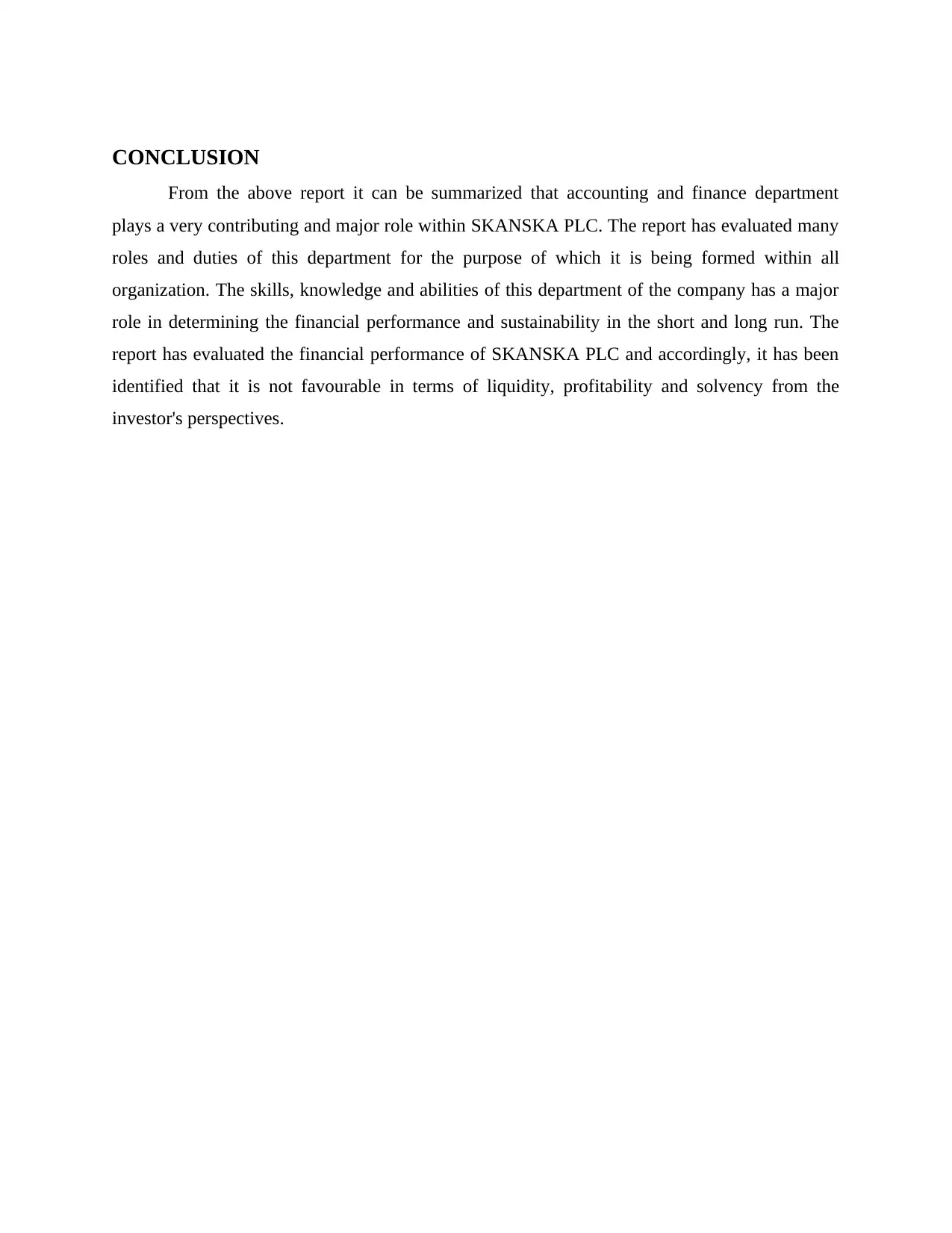
CONCLUSION
From the above report it can be summarized that accounting and finance department
plays a very contributing and major role within SKANSKA PLC. The report has evaluated many
roles and duties of this department for the purpose of which it is being formed within all
organization. The skills, knowledge and abilities of this department of the company has a major
role in determining the financial performance and sustainability in the short and long run. The
report has evaluated the financial performance of SKANSKA PLC and accordingly, it has been
identified that it is not favourable in terms of liquidity, profitability and solvency from the
investor's perspectives.
From the above report it can be summarized that accounting and finance department
plays a very contributing and major role within SKANSKA PLC. The report has evaluated many
roles and duties of this department for the purpose of which it is being formed within all
organization. The skills, knowledge and abilities of this department of the company has a major
role in determining the financial performance and sustainability in the short and long run. The
report has evaluated the financial performance of SKANSKA PLC and accordingly, it has been
identified that it is not favourable in terms of liquidity, profitability and solvency from the
investor's perspectives.
⊘ This is a preview!⊘
Do you want full access?
Subscribe today to unlock all pages.

Trusted by 1+ million students worldwide
1 out of 15
Related Documents
Your All-in-One AI-Powered Toolkit for Academic Success.
+13062052269
info@desklib.com
Available 24*7 on WhatsApp / Email
![[object Object]](/_next/static/media/star-bottom.7253800d.svg)
Unlock your academic potential
Copyright © 2020–2025 A2Z Services. All Rights Reserved. Developed and managed by ZUCOL.



